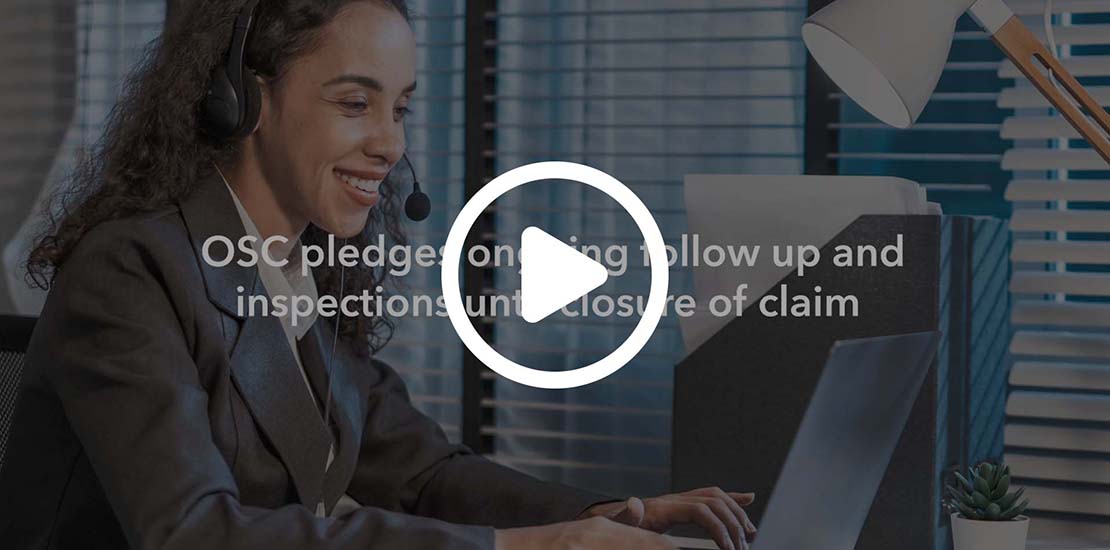As a lender, it is vital that your customers have the support they need when navigating the complex process of loss drafts. The ins and outs can be time-consuming and resource depleting. Outsourcing loss draft servicing takes the stress off you while ensuring homeowners – your customers – have someone to back them up. OSC’s Loss Draft capabilities do just that.
What is a Loss Draft?
![]() After a homeowner files a claim with their insurance company, they receive a check. The homeowner is then responsible for navigating the next steps themselves – check endorsement, what to do with the funds, and how to get the house repairs started. This is when the scenario becomes a loss draft. The homeowner turns to their lender for help managing the complexity, but lenders don’t always have the time or capacity to manage this undertaking.
After a homeowner files a claim with their insurance company, they receive a check. The homeowner is then responsible for navigating the next steps themselves – check endorsement, what to do with the funds, and how to get the house repairs started. This is when the scenario becomes a loss draft. The homeowner turns to their lender for help managing the complexity, but lenders don’t always have the time or capacity to manage this undertaking.
OSC’s role starts here. Outsourcing loss drafts allows us to take the load off the lender. We help homeowners solve the puzzle of check endorsements and deposits. We also assist as needed with contractors, ensuring they receive timely payments while finishing the repairs.
At OSC, we take pride in our unique capability to deliver hands-on customer service to lenders and their customers.
The Human Touch
 “One of the trends we have seen lately is that a lot of servicers and agencies are heading towards an online-based servicing platform with no call center or people to talk to,” said Vicki Koglmeier, Senior Manager of Loss Administration at OSC. “That works great for the standard, everyday case. But with loss drafts – especially higher dollar insurance claims – every single scenario is so different.”
“One of the trends we have seen lately is that a lot of servicers and agencies are heading towards an online-based servicing platform with no call center or people to talk to,” said Vicki Koglmeier, Senior Manager of Loss Administration at OSC. “That works great for the standard, everyday case. But with loss drafts – especially higher dollar insurance claims – every single scenario is so different.”
Constant changes happen throughout the repairs process, sometimes leaving the homeowner scratching their heads with frustration as they deal with electronic-only communication. While OSC is constantly moving forward and keeping up with the latest technology, our team recognizes the need for the human touch.
“At the end of the day, when people are frustrated, they want to pick up the phone and talk to somebody,” Vicki said. “We are still going to be there. We are giving the borrower reassurance while helping them walk through and understand the process.”
A Full Circle Call Center
![]() Vicki’s team includes a dedicated claims and loss drafts call center – pairing our lender-based claims and loss drafts teams together.
Vicki’s team includes a dedicated claims and loss drafts call center – pairing our lender-based claims and loss drafts teams together.
“Everybody on our team is trained in both claims and loss drafts,” Vicki said. “It allows for great communication and a greater borrower experience. From initial claim to loss draft, a consistent person is your contact.”
This gives both OSC and your clients the ability to really get to know each other on a first-name basis. The client’s contact is with them from beginning to end, really bringing the entire process full circle.
“It’s a highly dedicated team who is well-versed in both areas,” Vicki added. “It creates a very nice, cohesive atmosphere.”
Quick, Painless Virtual Inspections
![]() Gone are the days when homeowners had to find a suitable time for themselves and an inspector to meet in-person to assess damage. With virtual inspections, all it takes is a smartphone and a video link.
Gone are the days when homeowners had to find a suitable time for themselves and an inspector to meet in-person to assess damage. With virtual inspections, all it takes is a smartphone and a video link.
“You walk around and show the inspector the damages, including what has been repaired and hasn’t,” said Vicki. “That’s it. It’s super simple.”
Since pre-pandemic 2020, OSC dove deep into the world of virtual inspections with great success. With approximately 5,000 inspections overall, less than 10 were in-person, boots on the ground inspections.
Some advantages of virtual inspections include:
- Fannie Mae and Freddie Mac compliant
- Scheduled at borrower’s convenience
- Super quick – usually less than 30 minutes total
- Connect through a smartphone link – no downloaded app needed
- Reduced turnaround to five calendar days or less (on average)
- Comparable cost to in-person inspections
“Our customers really enjoy it,” Vicki added, “and the lenders love it because it just really speeds things up.”

Current Trends and Looking to the Future
Vicki’s expertise and first-hand knowledge in loss drafts and claims help her stay up to date with the latest industry trends. Always with her ear to the ground, she sees where some current trends may continue into the future – including the fact that a lot of servicers are still choosing to keep their loss drafts in-house.
Greater Thresholds Resulting from Historical Angst
![]() For the past 13 years, Fannie Mae and Freddie Mac have imposed very strict guidelines regarding repair facilitation, what dollar thresholds would need to be signed off on, and overall, very tight reigns on the entire process.
For the past 13 years, Fannie Mae and Freddie Mac have imposed very strict guidelines regarding repair facilitation, what dollar thresholds would need to be signed off on, and overall, very tight reigns on the entire process.
The further away we moved from the mortgage crisis in 2007-2008, the more the Loss Draft requirements have relaxed, and the industry standards have greater thresholds.
“If borrowers are current and working with a mortgage company, they can easily cash a $39,000 check right away to start their work.” Vicki said. “It just really helps facilitate getting houses repaired quicker and getting borrowers in and out the door. It speeds up the process overall.”
“By and large if you are being open, honest, and communicating with your borrowers from the very beginning of their loss draft file, to create a seamless process, it creates borrower confidence and keeps them engaged. They appreciate the servicing, and they then return to that lender. It keeps that relationship momentum going.”
An Increasing Trend: Electronic Fund Payments
![]() Although the tracking of loss drafts is something wanted across the board, many carriers are moving to electronic payments of funds – especially smaller dollar funds. With this comes a current and future challenge for facilitating a loss drafts program.
Although the tracking of loss drafts is something wanted across the board, many carriers are moving to electronic payments of funds – especially smaller dollar funds. With this comes a current and future challenge for facilitating a loss drafts program.
“If a carrier is issuing electronic funds payment to the insured, the lender may never know a claim even existed,” Vicki said.
She anticipates this to become the standard, with electronic payments increasing over the next decade.
“I suspect that there will come a point when the insurance carrier will ask for an electronic waiver from the lender to issue a larger payment amount to the insured,” Vicki added.
What remains to be seen is whether the industry will stay a check-centric environment or continue to lean more into electronic payments – particularly electronic funds to the lender as opposed to insured. Vicki said only time will tell.
Into the Future: OSC’s Latest Offering
![]() Vicki and her team are always finding new ways to serve current and prospective OSC clients with excellence. Our newest offering is paired with our claims capabilities.
Vicki and her team are always finding new ways to serve current and prospective OSC clients with excellence. Our newest offering is paired with our claims capabilities.
“We now offer assistance with filing claims on voluntary policies for vacant or abandoned homes only – no borrower can be occupying the residence,” Vicki said. “We can help the lender get the claim filed with a voluntary carrier for a small fee.”
The lender gives OSC the data, which allows OSC to submit the claim to the carrier. Our team then provides the lender with a document indicating the claim number and if an adjuster was assigned right away.
“It is just one more way we try to ease the load for our clients by creating a simple, seamless claims process,” Vicki added.

